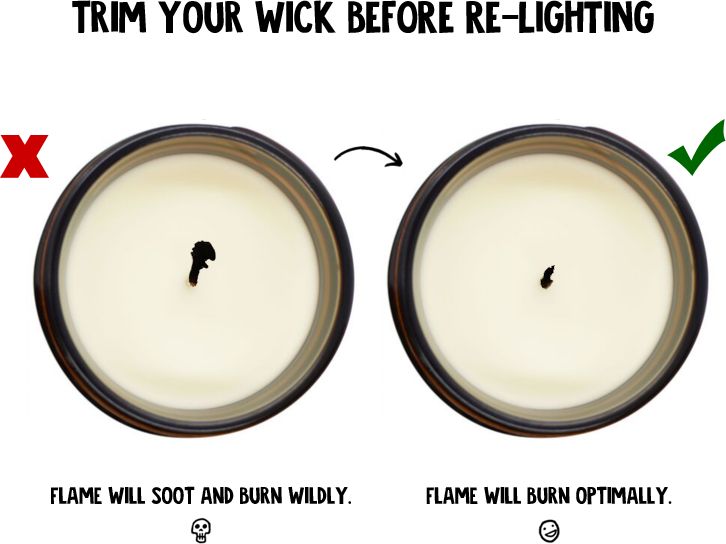What Happens If You Accidentally Breathe In Candle Smoke?
Is Inhaling Candle Smoke Dangerous?
The soothing, cozy ambiance created by candlelight makes candles a popular household item. However, some people worry that inhaling the smoke released while burning a candle could be harmful. With candles being burned for hours at a time in homes, vehicles, and public spaces, it’s important to understand the potential health effects of their smoke.
This article will explore what exactly is in candle smoke, examine research on short- and long-term health impacts, identify groups most at risk, provide safety tips, cover when to seek medical help, suggest alternative products, and ultimately empower you to make informed choices about candle usage.
Composition of Candle Smoke
Candle smoke contains several components including soot or particulates, volatile organic compounds (VOCs), and added fragrance chemicals (Candle Science).
Soot is made up of unburned carbon particles that result from incomplete combustion of the candle wax hydrocarbons (why is my candle smoking and the flame is dancing). These unburned particles get released into the air as smoke.
VOCs like benzene and toluene are released from the candle wax as it melts and vaporizes. When inhaled, these VOCs can be irritating and potentially harmful, especially in poorly ventilated spaces.
Many candles also contain synthetic fragrance chemicals that get emitted into the air as smoke particles. These added scents can contain a complex mixture of chemicals like phthalates and aldehydes.
Short Term Effects
Breathing in candle smoke can cause short term irritation and symptoms like coughing, irritated nose, throat, and lungs. According to one study, exposure to volatile organic compounds (VOCs) from scented candles is linked to coughing, throat irritation, and difficulty breathing. The soot particles in candle smoke can be an irritant and trigger coughing immediately after inhalation. Another common short term effect is nasal and throat irritation. The chemicals and particulates in candle smoke can inflame these sensitive mucous membranes lining the respiratory tract. This can lead to symptoms like a sore throat, runny nose, sneezing, and sinus congestion. Inhaling the irritants in candle smoke may also cause shortness of breath or wheezing as it inflames the airways and lungs. Overall, even brief exposure to candle smoke often results in coughing fits and temporary irritation of the nose, throat, and lungs in the minutes and hours after inhalation.
Long Term Effects
According to a 2023 study published in the National Center for Biotechnology Information, long term exposure to volatile organic compounds (VOCs) emitted from scented candles can potentially lead to serious health effects like cancer and lung damage [1]. When inhaled, these VOCs can cause cellular and DNA damage over time, increasing the risk of cancer.
Additionally, routinely breathing in candle smoke and soot may irritate lung tissue and cause inflammation. This type of lung irritation is linked to lung damage and breathing problems like asthma. A 2021 article from The New York Times notes that while occasional exposure to scented candle emissions is low risk, chronic exposure still has the potential to negatively impact respiratory health [2].
Those with asthma or other lung conditions should be especially cautious, as inhaling irritants like candle smoke can trigger asthma attacks. Regularly burning candles without proper ventilation may exacerbate asthma and other respiratory illnesses for sensitive individuals [3].
Most At Risk Groups
Some groups of people may be more susceptible to health effects from candle smoke:
Children – Children’s respiratory systems are still developing, making them more vulnerable to irritants. Their shorter height also means they are closer to the candle flame and more likely to inhale smoke and particulates (NY Times, 2021).
Elderly – Older adults often have a weakened immune system and existing respiratory conditions that can be aggravated by inhaled particles (Cleveland Clinic, 2022).
Those with respiratory conditions – People with asthma, allergies, COPD or other breathing issues can experience worsened symptoms when exposed to candle emissions. The smoke may trigger coughing, wheezing or shortness of breath (NIH, 2023).
Safety Tips
The use of candles needs to be approached with caution to avoid inhaling dangerous smoke that can irritate and harm the lungs. The following safety tips can help prevent overexposure to candle smoke:
Use candles sparingly. Limit burning to 1-2 hours at a time and avoid leaving them unattended for long periods. Take breaks between lighting candles to allow smoke to dissipate.
Ensure the room is properly ventilated when burning candles. Open windows, use fans, or run air conditioning to allow airflow and prevent smoke buildup in stagnant air [1].
Consider LED flameless candle alternatives, which provide the ambiance of real candles without any harmful smoke. These battery-operated options eliminate the fire and smoke risks of traditional candles [2].
Seeking Medical Help
If symptoms like coughing, wheezing, chest tightness, or breathing difficulties persist after accidental candle smoke exposure, it’s important to seek medical attention. The doctor may prescribe medications like bronchodilators, cough medicine, or steroids to help relieve coughing and open up the airways. Oxygen therapy may be required if oxygen levels are low. In severe cases, hospitalization may be necessary for breathing treatments or to monitor lung function. Watch for emergency warning signs like bluish lips or face, confusion, or fainting after smoke exposure, and get immediate medical care. Calling a doctor promptly when smoke inhalation symptoms don’t improve can prevent complications like chemical pneumonia from developing.
Sources:
https://www.healthline.com/health/smoke-inhalation
https://www.webmd.com/lung/smoke_inhalation_treatment_firstaid.htm

Preventing Exposure
The best way to avoid breathing in any potentially harmful candle smoke is to prevent exposure in the first place. Here are some tips for preventing exposure:
Place candles away from faces. Keep candles at least 1-2 feet away from you and others to reduce smoke inhalation. The further away, the better.
Extinguish candles when leaving a room. Don’t leave burning candles unattended. Blow them out or use candle snuffers when you exit the room so smoke doesn’t build up.
Use candles sparingly. Only light candles for short periods when you’ll be present. Overuse creates more smoke than necessary.
Ensure proper ventilation. Burn candles in open, well-ventilated areas. Avoid small enclosed spaces where smoke can’t dissipate.
Avoid drafts. Don’t place candles near vents, fans or open windows where drafts can disrupt the flame and cause smoke.
Trim wicks. Keep wicks trimmed to 1⁄4” before lighting to prevent smoke from long wicks.
Use candle alternatives. Consider battery-operated candles or essential oil diffusers for cleaner, smoke-free options.
With some simple precautions, it’s easy to enjoy candles while minimizing smoke inhalation risks.
Alternative Products
There are many alternatives to regular paraffin candles that don’t produce as much smoke. Some options include:
Beeswax and soy candles – These natural wax candles burn cleaner and cooler than paraffin, producing less soot and smoke. Beeswax candles contain no petroleum byproducts. Soy candles are made from soybean oil and also burn cleanly. Sources: Apartment Therapy, Lafco NYC
Essential oil diffusers – Diffusers disperse essential oils into the air to provide fragrance without any smoke or open flames. There are many styles, like ultrasonic, nebulizing, and evaporative diffusers. They provide aromatic benefits without fire risks.
Flameless candles – These use LED light to simulate the look of real candles without any smoke or fire hazard. Battery-operated flameless candles come in many styles, from tapers to pillars, and offer convenient ambiance.
Conclusion
In summary, accidentally inhaling candle smoke can cause irritation and respiratory issues, especially for those with lung conditions like asthma. The soot and chemicals in candle smoke make it potentially dangerous in large amounts. By avoiding overuse of candles, ensuring proper ventilation, using safer candle alternatives, and seeing a doctor if problems persist, the risk of breathing issues can be reduced. Though an occasional whiff likely causes no lasting damage, it’s wise to minimize exposure to avoid respiratory irritation. With some mindfulness and precaution, candle lovers can continue enjoying their favorite scents while keeping their lungs healthy.
Readers concerned about exposure should consult their physician, particularly if existing conditions could be aggravated. For most, following the venting and moderation tips above should provide adequate protection. Though a comforting part of home life for many, candles must be used responsibly to prevent potential health effects from smoke inhalation.


